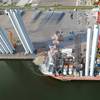MHI, Wärtsilä Agree on Engine Development
Mitsubishi Heavy Industries, Ltd. (MHI) and Wärtsilä Corporation of Finland have signed a joint development agreement on May 15, 2008 to design and develop new small, low-speed marine diesel engines of less than 450 mm cylinder bore.
The two companies see good business potential in pooling their resources and experience to develop new small marine engines of less than 450 millimetre (mm) cylinder bore. Such engines are suitable for a wide variety of small ship types, including bulk carriers, product tankers, chemical tankers, container feeder vessels, and reefer ships. Such ships are employed in worldwide trades but with the smaller types being specifically employed in short-sea and coastal services. The new engines shall meet the market needs for high efficiency, high reliability, compactness and environmental friendliness.
Details of the engines to be developed under this agreement will be announced in a few months time after the initial design studies have been completed.
This agreement is an extension of the strategic alliance created by MHI and Wärtsilä in September 2005. This alliance was formed on the basis of the successful joint development by the two companies of the Wärtsilä RT-flex50 and Mitsubishi UEC50LSE low-speed engine types.
Wärtsilä has its own range of low-speed marine diesel engines covering the power range of 5,650 to 84,420 kW. Today the Wärtsilä RT-flex engine types feature the latest electronically-controlled common-rail technology. MHI also has its own range of UE low-speed marine diesel engines covering the power range of 1,120 to 46,800 kW, and also has long co-operated in the manufacture of Sulzer and Wärtsilä low-speed engines going back to an agreement signed with Sulzer in 1925. The new engine types will reinforce the respective engine portfolios in the lower power range.
The project is led by a joint working group of engineers from both companies with supervision by a steering committee including senior management of the two companies.
It is envisaged that the new engine would be built by Wärtsilä’s and Mistubishi’s licensees world-wide.












